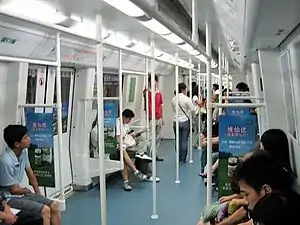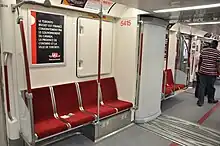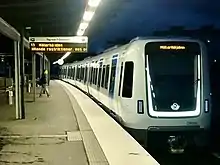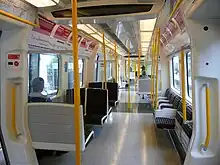Alstom Movia
The Alstom Movia (introduced as the Adtranz Movia and later sold as the Bombardier Movia) is a family of metro train cars designed by Adtranz and later built by Bombardier Transportation and Alstom. The structure and body shell are fully customisable for the needs of each system that orders it. Unlike most traditional metro trains, they usually have full-width gangways between carriages, allowing passengers to walk the entire length of the train. The design was developed by Adtranz, which was acquired by Bombardier in 2001. Since Alstom's acquisition of Bombardier in 2021, Alstom will be responsible for construction and delivery of future Movia metro train cars.[1]
| Alstom Movia | |
|---|---|
 A Delhi Metro MOVIA train | |
 Interior of MOVIA 456 for Shenzhen Metro Line 1 | |
| In service | 1998–present |
| Manufacturer | Bombardier Transportation, Alstom (2021–)[1] |
| Designer | Adtranz |
| Family name | Movia |
| Constructed | 1997–present |
| Specifications | |
| Traction system | IGBT– or SiC–VVVF |
| Traction motors | 3-phase AC induction motor or permanent-magnet synchronous motor |
| Electric system(s) |
|
| Current collector(s) |
|
| Bogies |
|
| Track gauge |
|
Guangzhou Metro (Lines 1 and 8), Shanghai Metro (Line 9), and Shenzhen Metro (Line 1) all use Movia 456 trains, while Bucharest Metro (Line M1, M3, M5) use the Movia 346. Movia tube and sub-surface stock are in service on the London Underground (designated S Stock on the Circle, District, Hammersmith & City and Metropolitan lines and 2009 Stock on the Victoria line), Toronto subway (designated Toronto Rocket on Line 1 Yonge–University and Line 4 Sheppard), Bay Area Rapid Transit (designated D and E series) and Delhi Metro (Phase II only). Singapore MRT's North South and East West lines ordered 106 R151 Movia trains, one of the largest orders in Singapore.
Design
The Movia is designed around a modular approach, which allows it to be adapted for use across a broad range of applications.[3] While developed as a standardised platform, both the structure and carriage bodies of the train are able to be extensively modified to conform with the varied requirements of a given operator. Reportedly, the Movia can be modified to better suit local operational conditions, while the train's steering and management system is easily accessible for periodic maintenance. Reduced operating costs have been achieved via the careful designing of the train carriages to readily facilitate access for maintenance and repairs, as well as for low lifecycle costs and with concern for environmental conditions.[3]
The Movia incorporates either a stainless steel or aluminium body, and an innovative propulsion system.[3] Each carriage is outfitted with relatively modern passenger information systems and closed-circuit television (CCTV) systems. They feature modern interiors and exterior design; for favourable accessibility, they are normally furnished with both wide doors and spacious gangways.[3] The carriages are also outfitted to provide relatively low interior noise levels, resulting in an improved environment for passengers.[3]
The Movia train is powered by an advanced propulsion system, which is credited with achieving relatively low energy consumption, known as the MITrac (Modular Integrated Traction system).[3] This propulsion and control system is capable of vehicles using 600 V–3 kV DC, 15–25 kV AC and diesel electric propulsion. In a typical configuration, the train is capable of achieving a maximum operational speed of 85 km/h (53 mph).[3] Each carriage is outfitted with FLEXX Metro 1000,[lower-alpha 1] FLEXX Metro 2000,[lower-alpha 2] FLEXX Metro 3000 or FLEXX Eco[lower-alpha 4] lightweight bogies, which reportedly enable optimum usage of vehicle capacity with less energy consumption. Other features of note include strong steering performance.[3]
Operators
Canada


- Toronto Transit Commission (Toronto subway)
- 80 six-car trains (480 cars in total)[4][5] on the Yonge–University and Sheppard lines: delivery began in October 2010 and the first train entered revenue service on July 21, 2011
China (mainland)
- Guangzhou Metro Movia 456 – 34 six-car units (204 cars).
- Shanghai Metro – 134 six-car units (804 cars).
- Shenzhen Metro – 22 six-car units (132 cars).
India
- Delhi Metro
- Kanpur Metro
- 67 three car trains (201 cars), with Alstom branding[1]
Romania

- Bucharest Metro
- 44 Movia 346 trainsets (264 cars), built between 2002 and 2008
Singapore
- SBS Transit (MRT)
- 92 three car trains (276 cars), on the Downtown Line in 2013 under C951/C951A
- SMRT (MRT)
- 106 six car trains (636 cars), on the East–West line in 2023 under R151
Sweden

- Stockholm metro
- 270 3-car C20 Movia sets (810 cars) originally built by Kalmar Verkstad and Adtranz (later acquired by Bombardier), as well as one 3-car C20F Movia set built by Bombardier with "FICAS" technology.
- 96 4-car C30 Movia sets (384 cars) have been ordered to be used as 48 full-length trains on the Red line. The first units were delivered in mid-2018 and entered passenger service in August 2020. The last units are expected to be delivered in 2022.[9]
United Kingdom

- London Underground
- 47 trains – Movia tube stock, 8 car (2009 Stock) for the Victoria line
- 192 trains – Movia sub-surface stock, 7 or 8 car (S Stock) for the Metropolitan, Hammersmith & City, Circle and District lines
- Total of 1779 cars
United States
Production
- Kalmar, Småland, Sweden – former Kalmar Verkstad, manufactured 270 C20 units and the C20F prototype for Stockholm and the BM2 prototype for Bucharest
- LEW Hennigsdorf, Hennigsdorf, Germany – former Lokomotivbau-Elektrotechnische Werke (later Adtranz/AEG Schienenfahrzeuge GmbH) – European orders outside of UK and initial cars for Delhi Metro
- Changchun Alstom Railway Vehicles Co,. Ltd., Changchun, China – joint venture plant with CRRC Changchun Railway Vehicles Co., Ltd. – Chinese and Singapore orders
- Savli Railcar and Electrical Component Manufacturing Plant, Vadodara, Gujarat, India – most cars for Delhi Metro and all cars for Kanpur Metro
- Thunder Bay, Ontario, Canada – former Canadian Car and Foundry plant (Hawker Siddeley Canada/UTDC) – Toronto order
- Derby Litchurch Lane Works, England, United Kingdom – London Underground order
- Plattsburgh, New York, USA – BART and New York City Subway orders
- Pittsburg, California, USA – BART order
- Craiova, Romania - joint venture with Electroputere Craiova, the series production for the Bucharest Metro
Notes
- London Underground
- Bucharest Metro, Stockholm Metro C20, Toronto subway
- Most trains
- Stockholm Metro C30
References
- Muniswamappa, Shilpashree; Collet, Coralie; Spohr, Alain (2021-09-18). "Alstom delivers the first trainset for Kanpur Metro". Alstom. Retrieved 2021-11-07.
- "FLEXX Metro Bogies - The pulse of cities" (PDF). Bombardier Transportation. Archived from the original (PDF) on 2020-02-19.
- "Bombardier Movia Metro Cars." railway-technology.com, Retrieved: 12 June 2018.
- Toronto Transit Commission (March 6, 2015). "TTC Service Summary – March 29,2015 to May 9, 2015" (PDF). Retrieved 2015-03-22.
- "Procurement Authorization Amendment to Purchase 10 Additional Toronto Rocket Train Sets – Purchase Order No. C31PD05761" (PDF). Toronto Transit Commission. 2015-03-26. Retrieved 2015-03-22.
- News – Media Centre. Bombardier. Retrieved on 2013-07-26.
- First video clip of set operating
- Delhi orders more Movia metro cars. Railway Gazette. Retrieved on 2013-07-26.
- "Nya tunnelbanetåg på Röda linjen".
External links
- Movia official web site Archived 2020-02-19 at the Wayback Machine